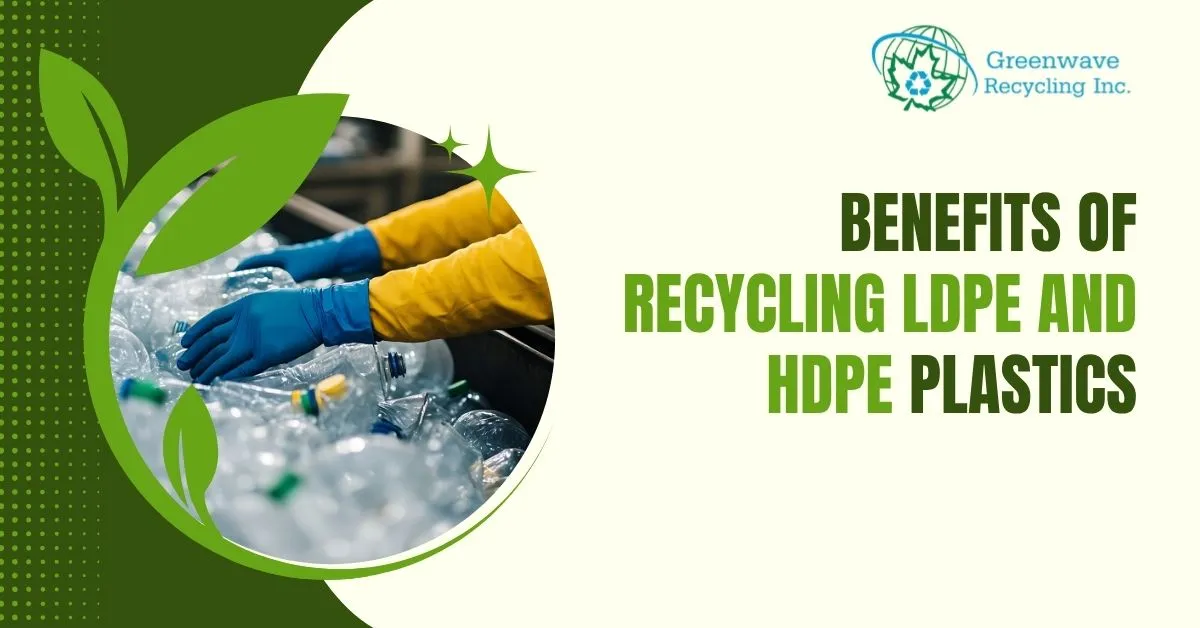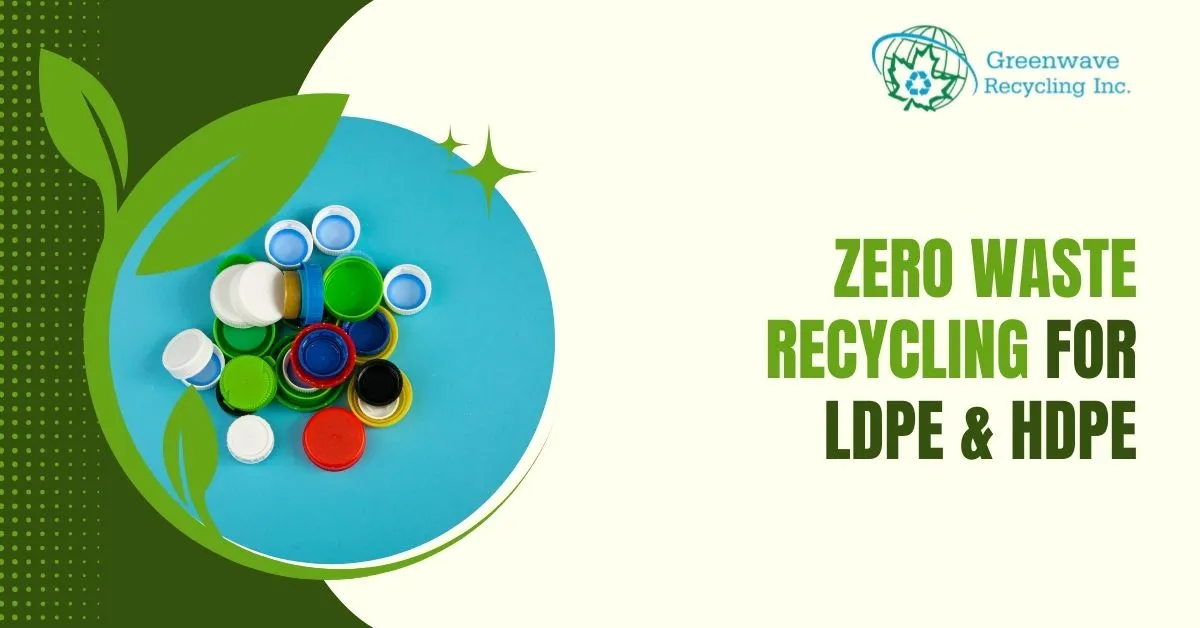Single-use medical plastics such as syringes, IV bags, surgical gloves and PPE (personal protective equipment)…

Plastic waste continues to be a major environmental concern across Canada. Among the most commonly used plastics in industrial and commercial settings are LDPE (Low-Density Polyethylene) and HDPE (High-Density Polyethylene). These materials are found in everyday products — from plastic bags and packaging films to detergent bottles, milk jugs, and industrial containers.
With Canada’s growing focus on sustainability and circular economy goals, recycling LDPE and HDPE plastics has become essential to reduce landfill waste, conserve natural resources, and promote responsible manufacturing.
This blog explores the key benefits of recycling LDPE and HDPE plastics, the recycling process, and how Canadian industries can lead the shift toward a greener future.
What Are LDPE and HDPE Plastics?
LDPE (Low-Density Polyethylene) and HDPE (High-Density Polyethylene) are both thermoplastic polymers derived from petroleum. Though similar in chemical structure, they differ in density, flexibility, and application:
- LDPE is lightweight, flexible, and commonly used for plastic films, grocery bags, and shrink wraps.
- HDPE is more rigid and durable, used for containers, pipes, detergent bottles, and heavy-duty packaging.
Both plastics are 100% recyclable, meaning they can be processed and reused multiple times without losing their fundamental properties.
The Importance of LDPE and HDPE Recycling in Canada
Canada generates millions of tonnes of plastic waste annually, and a large portion consists of polyethylene products. According to Environment and Climate Change Canada, only about 9% of plastic waste is recycled — the rest ends up in landfills or the environment.
Recycling LDPE and HDPE helps address this growing issue by:
- Reducing landfill volumes and extending landfill lifespan.
- Minimizing the extraction of virgin petroleum, which lowers greenhouse gas emissions.
- Supporting Canada’s Zero Plastic Waste Agenda, part of the national goal to eliminate plastic waste by 2030.
Benefits of Recycling LDPE and HDPE Plastics
1. Environmental Conservation
Recycling LDPE and HDPE plastics significantly reduces the amount of waste that ends up in landfills or oceans. It conserves natural resources and minimizes pollution caused by the production of new plastics.
Every tonne of recycled HDPE saves roughly 1.5 tonnes of CO₂ emissions, helping Canada meet its climate action commitments.
2. Reduced Energy Consumption
Producing recycled plastic products consumes far less energy than manufacturing from virgin petroleum. In fact, recycling HDPE uses about 88% less energy than producing new material.
This energy efficiency contributes to lower operational costs for manufacturers and supports the transition toward renewable, low-carbon industries.
3. Economic Benefits for Canadian Industries
The recycling industry in Canada is creating new economic opportunities. LDPE and HDPE recycling supports:
- Job creation in collection, sorting, and reprocessing sectors.
- Cost savings for manufacturers using recycled resins instead of virgin materials.
- Revenue generation from selling recyclable plastics to domestic and international markets.
As the demand for sustainable materials grows, Canadian recyclers and manufacturers can gain a competitive advantage through circular business models.
4. Compliance with Environmental Regulations
Canadian provinces, including British Columbia, Ontario, and Quebec, have introduced extended producer responsibility (EPR) programs requiring manufacturers to take responsibility for plastic packaging waste.
By implementing LDPE and HDPE recycling programs, companies ensure regulatory compliance and demonstrate commitment to Canada’s sustainability goals.
Looking to recycle LDPE and HDPE plastics efficiently? Contact us for sustainable, compliant, and cost-effective plastic recycling solutions across Canada.
5. Enhancing Corporate ESG Goals
Recycling plastics aligns with ESG (Environmental, Social, and Governance) objectives by demonstrating environmental responsibility, social accountability, and ethical business operations.
Companies that integrate recycling into their supply chains can improve brand reputation and attract environmentally conscious customers, investors, and partners.
6. Resource Recovery and Reusability
Recycling LDPE and HDPE allows recovered plastics to be reprocessed into valuable materials such as:
- Construction materials (plastic lumber, piping)
- New packaging and containers
- Agricultural films and reusable bags
This closed-loop recycling system ensures that plastics are continuously reused, supporting Canada’s circular economy and reducing the need for virgin resources.
How LDPE and HDPE Recycling Works in Canada
The recycling process involves several key steps to ensure plastics are properly collected, cleaned, and reprocessed into usable materials.
- Collection and Sorting
Plastic waste is gathered from manufacturing plants, distribution centres, and municipal recycling programs. Materials are then sorted by type and grade. - Cleaning and Shredding
Collected plastics are washed to remove labels, residues, and contaminants, then shredded into smaller flakes. - Melting and Pelletizing
The shredded LDPE and HDPE are melted and formed into pellets — known as recycled resin — which serve as raw material for new products. - Manufacturing and Reuse
Recycled pellets are used by manufacturers to create packaging, pipes, containers, and industrial materials.
Through this process, Greenwave Recycling and similar Canadian recyclers help reduce waste and support a sustainable materials lifecycle.
Challenges in Recycling LDPE and HDPE Plastics
While the benefits are substantial, the recycling process faces challenges that must be addressed:
- Contamination from food residues, adhesives, or mixed materials.
- Limited infrastructure in rural areas for collection and sorting.
- Fluctuating market prices for recycled plastic resins.
Investing in advanced sorting technology and strong public-private partnerships can help overcome these challenges and make plastic recycling more efficient nationwide.
Future of LDPE and HDPE Recycling in Canada
With Canada’s commitment to achieving zero plastic waste by 2030, the recycling of LDPE and HDPE plastics will continue to expand.
Emerging technologies, such as chemical recycling and AI-based sorting systems, will enhance recycling efficiency, while policies supporting extended producer responsibility will drive greater industry accountability.
Canadian businesses that embrace these innovations will not only comply with evolving regulations but also play a crucial role in creating a sustainable, circular economy.
Frequently Asked Questions
No. While both are polyethylene, they have different melting points and must be processed separately for high-quality recycling.
Yes. Many provinces have industrial and commercial recycling programs that accept LDPE and HDPE materials.
They can be turned into pipes, plastic lumber, containers, agricultural film, and new packaging.
Partnering with certified recyclers like Greenwave Recycling ensures proper collection, processing, and documentation.
Yes, when processed according to Canadian Food Inspection Agency (CFIA) and Health Canada guidelines.
Conclusion
Recycling LDPE and HDPE plastics is an essential step toward achieving Canada’s sustainability and zero waste goals. It helps reduce carbon emissions, conserve natural resources, and support eco-friendly industrial growth.


